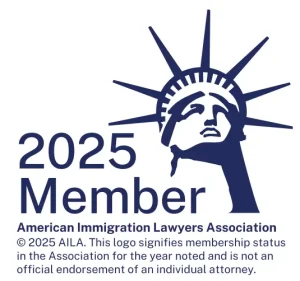Getting a green card for your spouse remains one of the most common immigration pathways in the United States. Nearly 40% of all family-based green cards are issued to spouses each year, making this process crucial for hundreds of thousands of couples. However, significant changes in 2025 have made the process more complex and scrutinized than ever before.
After 28+ years of practicing immigration law, I’ve guided countless couples through this journey. The fundamentals remain the same, but the details—and the stakes—have changed considerably. Here’s what you need to know about getting a green card for your spouse in 2025.
What’s Changed in 2025: Key Updates
The most significant change is the reinstatement of mandatory in-person interviews for marriage-based green card applications. USCIS has implemented this requirement as part of a comprehensive anti-fraud initiative, recognizing that marriage fraud has become increasingly sophisticated.
Additionally, USCIS has updated critical forms and procedures:
- New Form Requirements: Updated versions of Forms I-130, I-485, and I-129F with stricter formatting and anti-fraud language
- Concurrent Medical Exam Filing: Form I-693 must now be submitted with your initial application packet
- Enhanced Documentation Standards: Higher evidence thresholds for proving bona fide marriages
- Stricter Payment Rules: Separate payments required for each form—no combined payments accepted
These changes reflect a zero-tolerance approach to marriage fraud while maintaining pathways for legitimate couples.
Understanding Your Situation: Which Process Applies?
US Citizen Marrying a Foreign National
If you’re a US citizen married to someone who entered the country legally, you have the most straightforward path. Your spouse may be eligible for adjustment of status, allowing them to get their green card without leaving the United States.
Key advantages:
- No annual visa number limitations
- Faster processing (typically 8-13 months)
- Spouse can remain in the US during processing
- Work authorization available while case is pending
Lawful Permanent Resident (Green Card Holder) Marrying a Foreign National
This scenario involves additional complexity. Spouses of green card holders fall under the F2A preference category, which means:
- Visa number limitations apply – currently over 1.17 million approved petitions are waiting for visa availability
- Longer wait times – particularly for applicants from high-demand countries like Mexico, India, China, and the Philippines
- Two-step process – first the petition approval, then waiting for visa availability
When Your Spouse Entered Without Inspection
If your spouse entered the United States illegally, they cannot adjust status here, regardless of your marriage. They must use consular processing, which creates additional challenges:
- Mandatory departure from the US for consular interview
- Potential 10-year bar if they’ve been unlawfully present for over one year
- Waiver requirements – typically the I-601A provisional waiver before departure
This scenario requires careful planning and often involves significant risk.
The Process: Step-by-Step for 2025
Step 1: File Form I-130 Petition
The US citizen or permanent resident spouse files Form I-130 to establish the qualifying relationship. Under 2025 requirements:
- Must use the current form edition (check USCIS website for latest version)
- Include comprehensive evidence of bona fide marriage
- Pay separate filing fee (currently $675)
- Expect enhanced scrutiny of supporting documentation
Step 2: Determine Your Path
For Adjustment of Status (if spouse is in the US legally):
- File Form I-485 concurrently or after I-130 approval
- Include Form I-693 medical examination (mandatory concurrent filing)
- Apply for work authorization (Form I-765) and travel document (Form I-131) if desired
For Consular Processing (if spouse is outside the US or entered illegally):
- Wait for National Visa Center processing after I-130 approval
- Complete DS-260 online application
- Attend consular interview in spouse’s home country
Step 3: Prepare for Mandatory Interview
All marriage-based applications now require in-person interviews. This represents a return to pre-2017 procedures and reflects USCIS’s commitment to fraud detection.
Interview preparation essentials:
- Comprehensive documentation of your relationship timeline
- Joint financial records, lease agreements, insurance policies
- Photos spanning your relationship
- Affidavits from family and friends
- Detailed knowledge of each other’s background, family, and daily routines
Step 4: Conditional vs. Permanent Status
If you’ve been married less than two years when the green card is issued, your spouse receives a conditional green card valid for two years. You must file Form I-751 to remove conditions before the card expires.
Marriages of two years or more at the time of green card issuance receive immediate 10-year permanent resident cards.
Common Challenges and How to Address Them
Large Age Differences
Significant age gaps between spouses trigger additional scrutiny. Document your relationship’s development thoroughly, including how you met, courtship timeline, and shared life goals.
Different Cultural or Language Backgrounds
USCIS recognizes legitimate international marriages but looks for evidence of genuine communication and shared experiences. Translation services, travel records, and cultural integration efforts strengthen your case.
Previous Immigration Violations
Prior overstays, visa violations, or removal proceedings don’t automatically disqualify you, but they require careful legal analysis. Waivers may be available, but timing and strategy are crucial.
Military Families
Military spouses may qualify for Parole in Place, which can cure unlawful entry and allow adjustment of status in the United States. This discretionary benefit requires strong evidence of hardship and military service.
Financial Requirements: Affidavit of Support
The US citizen or permanent resident must file Form I-864, proving they can financially support their spouse at 125% of the federal poverty guidelines. Current minimums for 2025:
- Household of 2: $26,200 annual income
- Household of 3: $33,000 annual income
- Additional persons: Add $6,800 per person
If you don’t meet income requirements, joint sponsors or asset-based calculations may be available.
Processing Times and Costs
Current processing times (as of 2025):
- Form I-130: 10-15 months
- Form I-485 (adjustment): 8-13 months
- Consular processing: 12-18 months total
Total costs:
- Adjustment of status: Approximately $3,005
- Consular processing: Approximately $1,340
- Legal fees vary but typically range from $2,500-$5,000
Red Flags That Trigger Additional Scrutiny
Based on my experience, certain factors consistently result in enhanced review:
- Short courtship periods before marriage
- Limited shared residence history
- Significant financial disparities between spouses
- Previous marriage-based petitions by either party
- Inconsistent statements in forms or interviews
- Lack of commingled finances or shared obligations
Why Professional Help Matters
The 2025 changes have made marriage-based green card cases significantly more complex. What used to be straightforward paperwork now requires strategic planning, comprehensive documentation, and careful preparation for mandatory interviews.
In my 28+ years of practice, I’ve seen how small mistakes can derail cases and create years of delays. The current environment demands precision and expertise to navigate successfully.
State-Specific Considerations for Montana, North Dakota, and Wyoming
Our regional location creates unique advantages:
- Lower case volumes often mean faster processing at local USCIS offices
- Experienced local officers who understand our agricultural and energy industry employment patterns
- Reasonable travel distances to interview locations in Helena or Denver
- Strong community ties that support evidence of bona fide marriages
Next Steps: Getting Started
If you’re ready to begin the green card process for your spouse, here’s what I recommend:
- Gather comprehensive relationship documentation – start this process early
- Assess any potential complications – prior immigration violations, criminal history, or complex family situations
- Develop a strategic timeline – coordinate work authorization, travel needs, and family planning
- Prepare financially – budget for government fees, legal costs, and potential travel expenses
The marriage-based green card process has become more challenging in 2025, but it remains a reliable path to permanent residence for genuine couples. With proper preparation, comprehensive documentation, and experienced legal guidance, you can successfully navigate this process.
Success in this area requires both knowledge of current law and practical experience with USCIS procedures. After nearly three decades of practice, I’ve developed the insights and strategies that make the difference between approval and denial.
Ready to start your spouse’s green card process? Contact our office to schedule a consultation and learn how we can help you navigate the 2025 requirements successfully.

